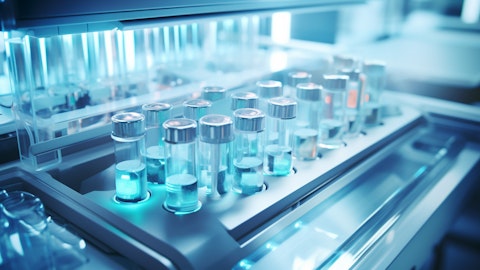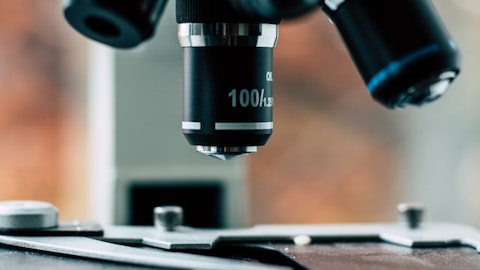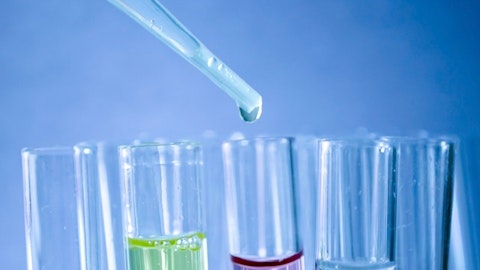James Hippel: Yes, Dan, I’ll just add to that. As Chuck just ended with, I think it speaks to the productivity nature of the instrument. We’ve been saying all along, it’s an amazing productivity tool. And in this time, as tightening budgets and concerns about funding should help. That’s what’s driving the consumable growth there. So it truly is the productivity tool. We’ve been saying it all along.
Daniel Arias: Yes. Okay. And then maybe just on ACD, 9% growth, I think you said during the quarter. Do you think that can get back up into the double-digit range? And then along those lines, can you just touch on where you are now just in terms of the need for additional commercial scale up there? And then whether you think usage in the clinical translational setting is a reasonable expectation in one of the things that you need in order to get back up into that 2-digit number?
Kim Kelderman: Hey Dan, it’s Kim. Thanks for the question. Absolutely. I think it was mainly Apex slowing us down a little bit this quarter. By fixing just that or normalizing, we will be back in the double digits. That’s the entitlement for not only the end markets but also our unique solution with the RNA scope portfolio of products. Think about Lunaphore is going to keep this business a boost as well, right? And we will definitely have more pull-through on the Lunaphore boxes, to COMET specifically. And then last but not least, our clinical business has been outpacing the overall product portfolio already and it’s becoming more than 10% of our revenues portion. So I think the undoubtedly answer is, yes, it will be back in double digits.
Daniel Arias: Okay. Just really quickly, Kim, is the percentage of revenues from — in China for your spatial business similar to the overall corporate average?
Kim Kelderman: No, it’s much lower.
Daniel Arias: Okay, thank you.
Kim Kelderman: Thank you.
Operator: Our next question comes from the line of Jacob Johnson with Stephens. Please proceed with your question.
Unidentified Analyst: Hi, good morning. This is Hannah on for Jacob. Thanks for taking my questions. If the macro remains a headwind well into 2024, how does this impact your view on organic investment? Will you try to manage profitability? Or does this change your approach to organic investment?
Charles Kummeth: Yes. Jim can cover this.
James Hippel: Yes. The short answer is no. I mean we are putting in productivity measures in place. We have been anticipating this throughout the quarter, and we continue to do that. We are, of course, pacing our investments accordingly. But our intention is to hold the margin guidance that we gave out earlier in the year. and manage our productivity to that while still investing in our growth platforms. So we’re — that’s what we’re paid to do is manage the support of the business given the current environment while still investing for the future, and that’s what we intend to do.
Unidentified Analyst: Thanks. And then can you talk about the outlook in proteins and antibodies for the remainder of the year? Do you expect to end the bulk orders to be coming back?
Charles Kummeth: Yes, I’ll cover that. I just had a meeting yesterday with the team and bulks are on the rise. So that’s a very good early indicator that OEM business be returning. Destocking, as Jim said, it’s kind of largely behind us. We’re starting to see discussion on orders now in some very large orders. So I think we’re turning the corner on that. I think our run rate business is hopefully kind of bottomed here. We’ll start positioning that out. I mean we had probably the worst quarter and 10 years of Fisher this last quarter, and we see that kind of flattening as well. I mean they talked about it on their call as well, and where that — the segment that lives and it couldn’t have been very great. But these labs are running out of stuff.
They’ve got to start buying again, and we’re starting to see the first inklings of that. So we think run rate will start improving some. And I think our retail overall will start improving. Remember now, our that’s not a majority of our revenue. So it takes all these things together to give us in the double-digit growth. But they all matter. And this part here, I’m kind of bullish looking forward finally.
Operator: Our next question comes from the line of Patrick Donnelly with Citi. Please proceed with your question.
Patrick Donnelly: Hey guys, thanks for taking the questions. Maybe first just on the biopharma performance in the quarter. Can you just talk about what you saw across the customer set and how things progress throughout the quarter, kind of the linear performance? And then maybe just disaggregate between the trends, smaller biotech versus mid and large pharma, a few peers suggest that things may be deteriorated as the quarter went? So curious what you guys saw?
Charles Kummeth: Yeah. Well, overall for the company, our academic versus biopharma is largely even about the same, but it was lopsided. So it was much stronger for biopharma in Europe okay, than it was in U.S., U.S. was low almost mid-single-digit growth. So that’s a much poorer performance than usual for us in the U.S. As Jim said, most of our pain was in the U.S. and then China and it was on the biopharma side. All in, without China, we actually didn’t do too bad because academic was not too bad. I mean, probably better than many quarters in the past quarter, to be honest. So we’re waiting on that biopharma to come back. And of course, as you mentioned, biotech is part of that biopharma and biotech is still soft out there.
The funding environment for biotech, small to medium companies going after their second or third round or trying to get that next way the clinical is going or rejuvenate the clinicals they’re in, it’s just softer. They’re all being very careful because money is tight. It’s going to change, but it’s going to be a quarter or 2, I think on that part of biopharma. Pharma is just being conservative because they’re just being conservative because they just see the wins, the way they’re looking, and that can turn on a dime. I’ll give you some evidence why that can be very, very quick to move. We actually had a very good quarter on our immunoassay, ELISA, dual sets, high single-digit growth. and that was not the case a quarter or 2 ago. So that could be early evidence of things starting to flip because that’s mostly farmer driving most of that business.
So ELISA is still more or less a standard for driving testing and clinicals. So.



